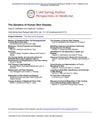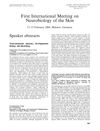Development of Heritable Melanoma in Transgenic Mice
March 1998
in “
Journal of Investigative Dermatology
”
TLDR The transgene likely activated an oncogene or interrupted a tumor suppressor gene, causing melanoma in mice.
In this study, transgenic mice were created using a DNA fragment known as Clone B, which unexpectedly led to the development of melanin-containing tumors, suggesting disruption of genes regulating cell growth in melanin-producing cells. The research involved 519 mice, with 435 being transgenic, and found that the insertion of Clone B DNA likely activated oncogenes or interrupted tumor suppressor genes, leading to melanoma development without exposure to carcinogens or UV radiation. The study highlighted the progressive stages of tumor development, with lesions resembling human melanoma observed in various organs. The findings provided a novel model for studying the genetic and molecular mechanisms underlying melanoma development, emphasizing the role of the transgene integration site in tumor development and the correlation between early lesion appearance and shorter lifespans.


